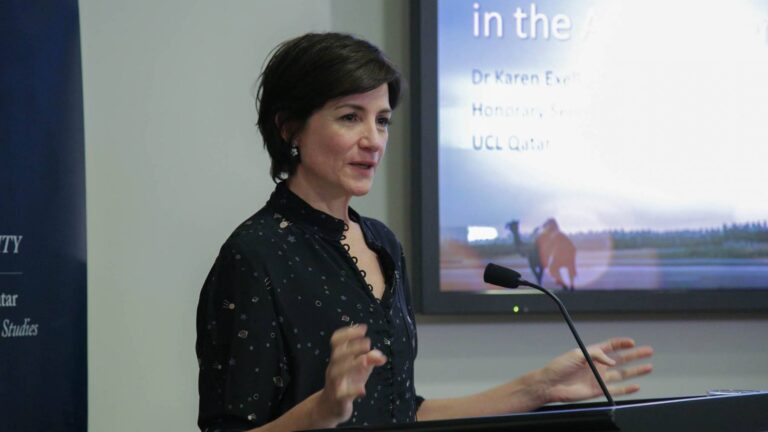Dialogue Series, Race & Society, Regional Studies
Museums and Modernity in the Arabian Peninsula

Karen Exell, Honorary Senior Research Associate at UCL Qatar, and a consultant at Qatar Museums, delivered a CIRS Monthly Dialogue lecture, titled “Museums and Modernity in the Arabian Peninsula,” on Tuesday February 23, 2016. Highlighting some key arguments from her forthcoming book Modernity and the Museum in the Arabian Peninsula (Routledge, 2016), Exell recounted that when she first arrived to Qatar with the task of setting up an institution to cultivate professional museological practices, the general consensus was that no such practices existed in the local context, and that Qatar was a “tabula rasa” in need of such imported knowledge and services. However, after spending time in the country and researching the local museological landscape, she argued that a very different picture emerged.
Exell explained that there are two simultaneous and oppositional discourses of cultural production currently being articulated in the region. These are presented as oppositional in terms of both style and content: modern art is seen as a product of Western art history, while traditional cultural practices draw on the oral histories and traditional practices of the region. These binary cultural productions are also presented as providing contrasted cultural experiences: one evokes an internationally-recognized art world, while the other invites a dialogic and immersive interaction with traditional regional productions. In order to examine how these discourses have been put into practice, Exell compared the Museum of Islamic Art in Qatar with the Saif Marzooq Al-Shamlan and Bait Al Outhman museums in Kuwait.
“The Museum of Islamic Art draws extensively on the Western paradigm of museological expertise,” she said, and is a prestige project that attempts to create a new global cultural center within Qatar. Such “engagement with Western-style museums was and is a strategic choice by the ruling families and elite actors,” and has been geared towards realizing a multitude of agendas over the years. Following independence, museological practices aided in nation-building, creation of consistent historical narratives, and legitimizing the status of the region’s ruling families. In the contemporary period, they are “a means of branding nations and gaining symbolic global power through accessing cultural capital,” she noted.
The Saif Marzooq Al-Shamlan and Bait Al Outhman museums in Kuwait, meanwhile, represent centers for the protection of local histories and traditional knowledge. Since these cultural forms are “rich in the kind of heritage that orthodox Western heritage models struggle to accommodate: intangible, performative, and embodied,” they are hard to promote or export. Simply put, they do not fit within the Western museological paradigm. However, Exell argued, while these local museological practices are deemed of little international value, they are of extreme importance in supporting and creating national identities and narratives.
It is by examining the rhetoric surrounding these supposedly contrasting cultural spheres that one can begin to understand how the two discourses actually play towards specific and strategic regional agendas, she said. As the Gulf states attempt to exploit the immense wealth created through hydrocarbon industries, these nations must also answer to how they are protecting against the encroachment of rapid regional transformations. Even as certain elements of modernity are being celebrated, there is a simultaneous call to strengthen local heritage as defense against what is perceived to be an onslaught and effacement of local histories anc cultures. This balancing act between the old and the new is exemplified in the two types of cultural engagements practiced in the region.
Ultimately, Exell argued, “the rhetoric of fusing the traditional and the modern represents the region’s approach to modernity…an agenda of retaining cultural identity in balance with aspects of a more secular modernity, while the rhetoric of engagement with global art and ideas of the universal is a method of discursively bridging cultures—bridging the East and the West and bringing people together—is repeatedly emphasized by actors investing in and producing the global art projects.”
v:* {behavior:url(#default#VML);}o:* {behavior:url(#default#VML);}w:* {behavior:url(#default#VML);}.shape {behavior:url(#default#VML);} 0 0 1 211 1209 10 2 1418 14.0 Normal 0 false false false false EN-US JA X-NONE /* Style Definitions */table.MsoNormalTable {mso-style-name:”Table Normal”; mso-tstyle-rowband-size:0; mso-tstyle-colband-size:0; mso-style-noshow:yes; mso-style-priority:99; mso-style-parent:””; mso-padding-alt:0cm 5.4pt 0cm 5.4pt; mso-para-margin:0cm; mso-para-margin-bottom:.0001pt; text-align:center; mso-pagination:widow-orphan; font-size:12.0pt; mso-bidi-font-size:11.0pt; font-family:Georgia; mso-ansi-language:EN-US;}
Karen Exell directed the MA in Museum and Gallery Practice at UCL Qatar from 2011-2015, after teaching museums studies and holding curatorial positions in university museums in the UK for several years. She is currently involved in two QNRF-funded research projects, as a PI on project researching museum pedagogy in Qatar and the region, and as LPI on project exploring the concept of national identity in relation to the planned new National Museum of Qatar. Her recent publications include the co-edited volumes, Cultural Heritage in the Arabian Peninsula: Debates, Discourses and Practices (Ashgate, 2014), and Museums in Arabia: Transnational Practices and Regional Processes (Ashgate, 2016).
Article by Suzi Mirgani, Managing Editor for CIRS Publications.